|
Getting your Trinity Audio player ready...
|
The coronavirus outbreak has changed the way we work, go to school, shop, inform ourselves, and much more. In the chaos that it’s wrought, publishers have found themselves with much more to do – and in the rush to update, many have started to lose focus on audience habits. The danger is: with this focus gone, they risk losing their audiences too.
Our data scientists have been studying reader patterns. We have witnessed a tremendous shift in the way people consume online news. We saw the charts on overall online consumption go rocket high, so we thought we’d do what we do best: collate our findings and present them to you to take back to your newsrooms with some actionable insights alongside.
Data available in smartocto’s Story Value Engine holds some very important insights for editors, publishers, and anyone else involved in creating online content – and these will help make real connections with the audiences while covering the news on coronavirus. Some of what we discovered was far from surprising, but there were results which – as our CMO puts it – knocked us out of our fancy socks.
And then the virus hit us …
We’ve picked five remarkable insights that could help online media professionals get a sense of what has changed and just how much.
So here’s what we’ve found:
- People read about coronavirus consistently throughout the day
- People broadly read the same amount of corona related and non-corona related articles
- Search is the most common content discovery method
- Corona-related stories are not the social media magnets you might expect
- Readers react very differently to coronavirus content, depending on where they are in the world
A little note about all the data stuff
Our data was collected by looking at 31 websites that use smartocto to fuel their publishing strategy with actionable insights. These news outlets are principally located in Germany, Switzerland, Belgium, Netherlands, and Norway. Our data set contains the data for the first four months of 2020, which equates to 1.5 billion article reads. That’s 1 500 000 000. We don’t mess around with small data sets here.
Let’s dive a little deeper, shall we?
1. No attention dip on corona
People are consistently reading about coronavirus throughout the day
Working from home, schooling from home, barely leaving our houses at all: the Corona Era has changed the patterns of news consumption for most of us as readers. The implications for us in our newsrooms have been just as significant. When it comes to busy hours for online news outlets, all is decidedly not business as usual – and normal scheduling and publishing practices should not be copied across from Life Before Covid-19.
So let’s jump in.
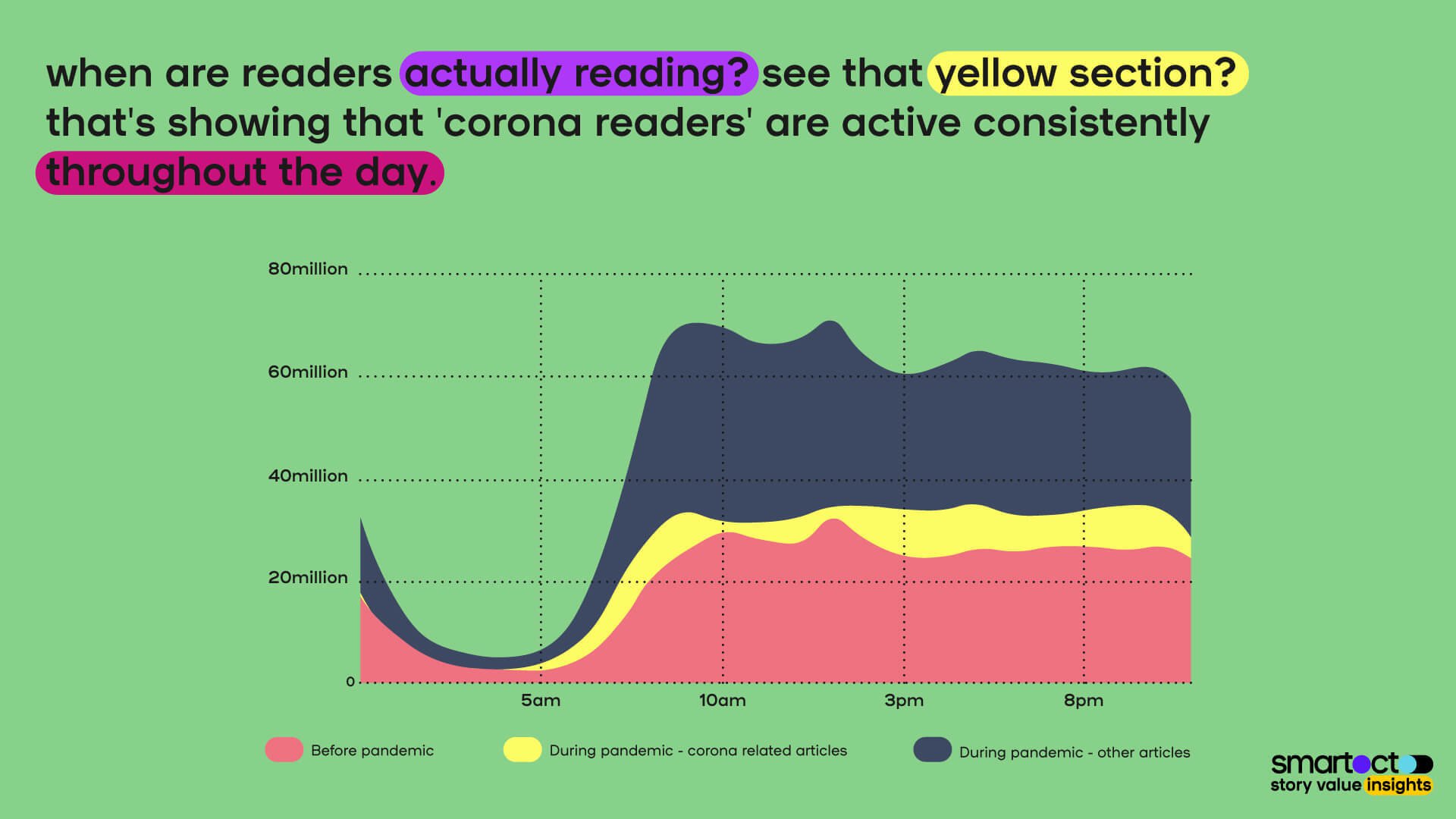
What’s fascinating about this graph is that the peaks, troughs, and plateaus visualised here correlate pretty well with the workday as was – and what it has changed into. Before, the Article Read rate throughout the day spiked at 10am which coincides with the start of work (if you’re a late starter) or a coffee break (if you’re not), then peak at 1pm at what is probably lunchtime, and subsequently peter out during the afternoon to a stable plateau until bed.
During corona, when most of us have found our working routines (and locales) changed, these distinct patterns of online news attention have remained similar, but amplified. We’ve been reading a lot more stuff. The patterns remain, but the volume has increased.
All except for articles about corona. Look at that yellow section. Attention remains high throughout the day – but it’s stable and without the large spikes, though mini-peaks exist.
Our reading habits have changed during corona
We not only read more about the pandemic, but we’re likely to read about it throughout the entire day. That’s new.
So, what are these mini-peaks an indication of? Well, coffee breaks and meals, certainly – but it might also be the case that the evening plateau could be explained by people who might be searching online for further information after watching the news, or a TV show, or engaging in those seemingly ubiquitous Zoom socials where – let’s face it – the topic of Covid-19 comes up.
What’s significant is that news consumption is tightly related to our daily routines – the windows of opportunity we have to search and explore topics of interest to us. What’s more, nuance is important: as evidenced by the different patterns to how people read Corona-related stories, it’s quite possible different topics may have their own patterns too.
Get on schedule
Has your publishing schedule stayed the same since all this kicked off? If you’re publishing to respond to peaks of yore, you could be missing out on reaching a highly engaged audience, constantly searching for something to read. If you have a Corona-related story worth publishing, our clients’ experience shows that it may not always be necessary to wait until the next day, if it’s ready at 9pm.
2. Never neglect the rest: Non-corona related news content is still very important.
The majority of readers consume the same amount of corona related and non-corona related stories.
Mark Schaefer famously wrote about ‘content shock’ – the phenomenon where we’re overwhelmed with too much information. It’s possible that readers now face a problem of ‘corona-content shock’ – a feeling that digital front pages cover only the latest on the pandemic. Sure, that’s important, but make no mistake: your readers are reading other stuff too – and now more than ever, a bit of light relief (or just relief from corona) is super important.
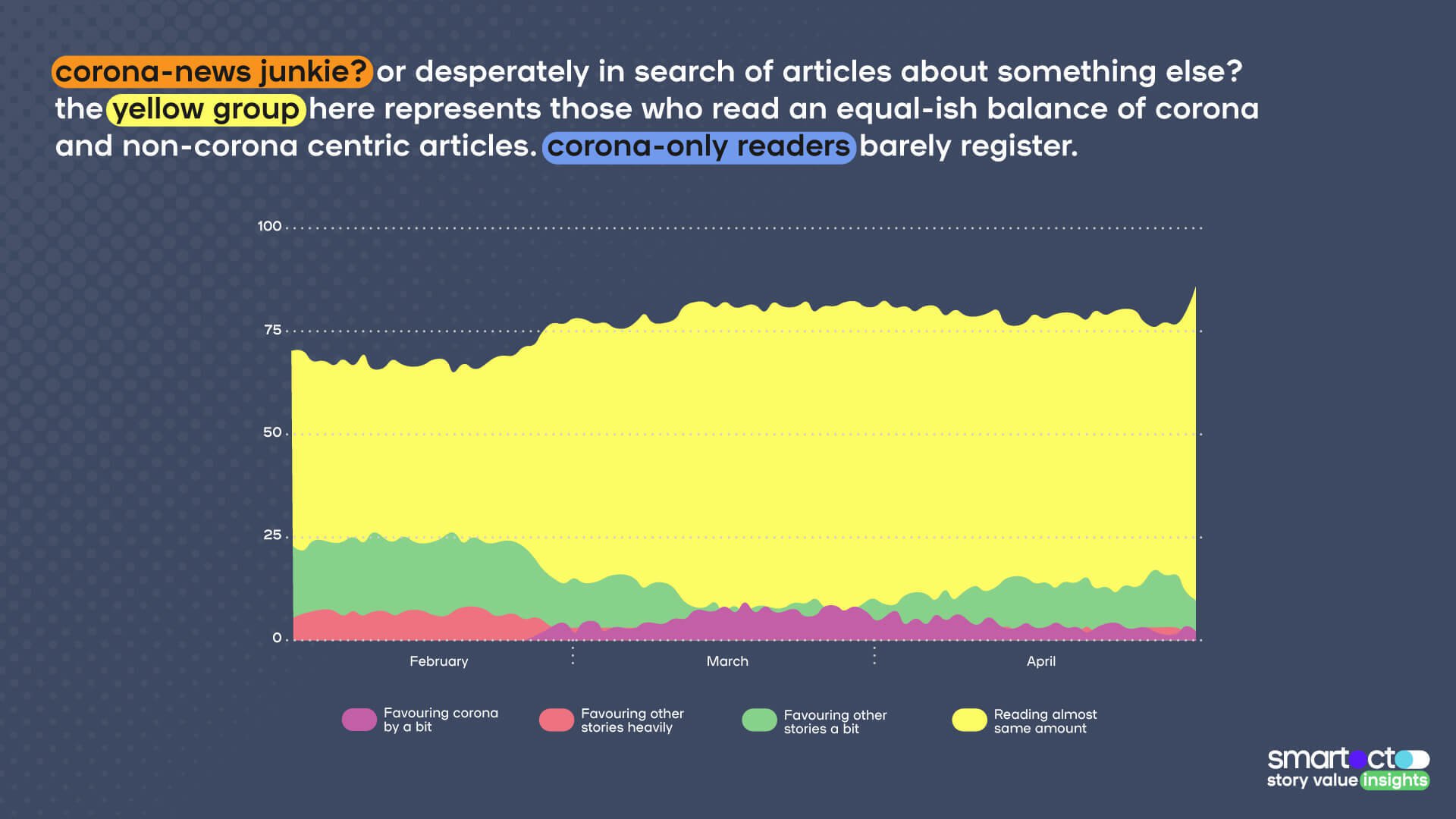
The emphasis on corona coverage doesn’t necessarily correlate with levels of reader interest, and here’s why.
Between the start of March and the beginning of April, almost 80% of daily readers consumed equal amounts of corona and non-corona related content. As the graph shows, this isn’t just a marginal trend – a significant proportion of users fit into this category.
The second largest group’s balance of reading choices is weighted slightly more towards non-corona related stuff, but even this group represents only just over 11% of cases.
How about those who read more corona-virus-related articles? (And, to be precise, here we mean those who read 2-4 more corona articles than non-corona ones per day. Glad you asked)
This group clocked in at just under 5% of the surveyed sample. And those who read more than five corona stories than other content? They barely registered here – even when the pandemic was at its height. Editors should be aware that people are interested in a balance of stories – they want to be informed about corona, yes, but we all need other things to read as well.
Even when the pandemic was at its height, readers still sought out articles about other subjects. This data indicates that reader interest changes fast. If you’re properly data-informed you’ll be agile enough to react to these changes in demand and serve the content your audience craves, when they need it. It’ll look like you’re ahead of the game, and anticipating their questions.
This also means you need to get your recommendations to other stories in place. If people read multiple corona related articles they tend to want to read something else (perhaps as an antidote). So, get comfortable on non-corona topics, serve your audience these articles, play with the balance, learn what works, and optimise from there.
3. Corona is search-driven: SEO might be more important than ever
The percentage of readers who search for news is four times higher for virus-related stories
Right now, when people want to get corona updates, it’s all about search. Readers are less likely to explore a specific news portal’s coverage when it comes to getting updates and information as they are to just cast the net wider. It’s a marked difference from what we’d like to believe our audiences do: click onto our site and spend time perusing the updates and articles presented to them.
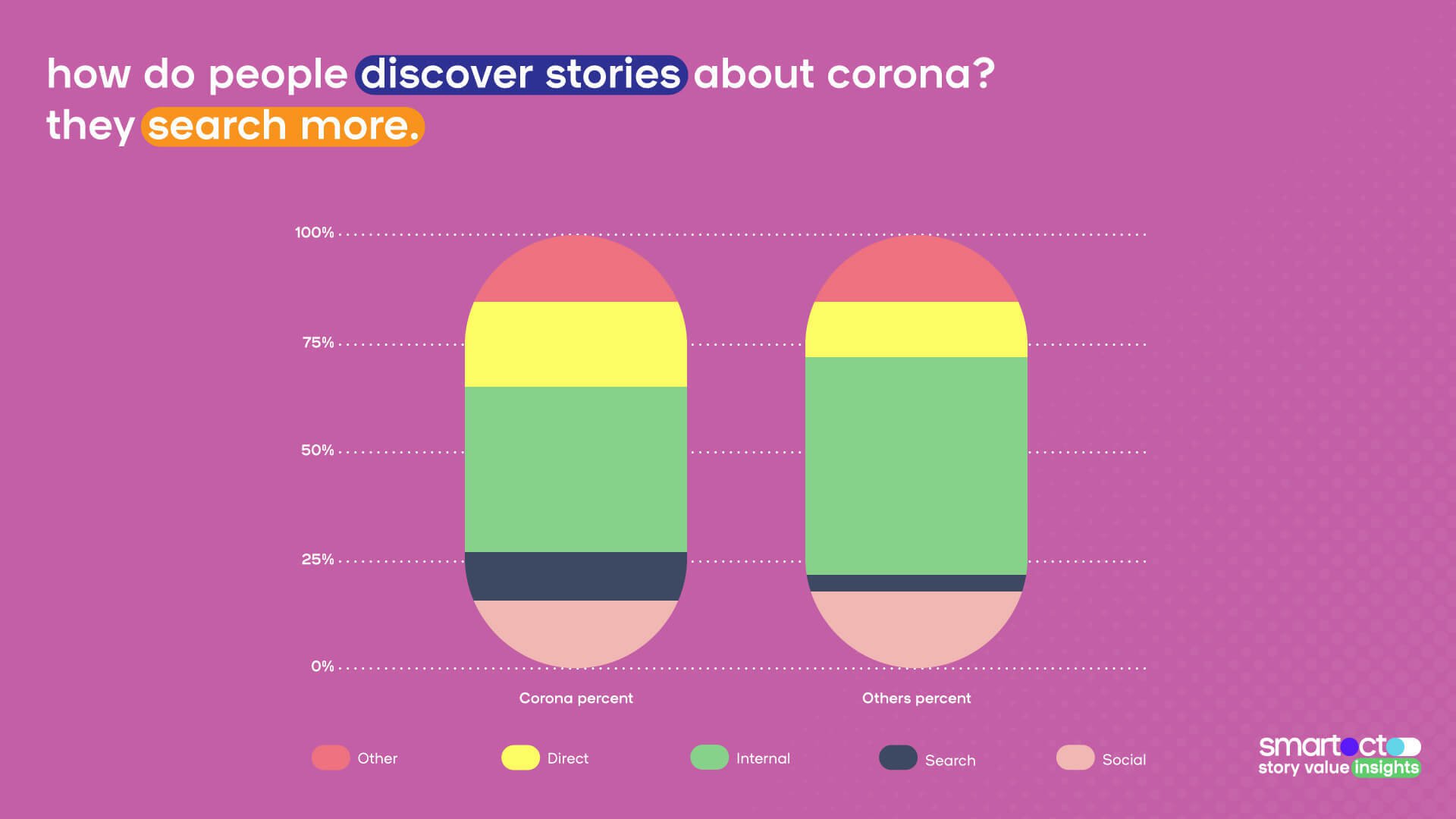
There are obviously marked differences between the user behaviour visualised in our findings here. The number of readers who find virus-related stories via search engines are four times higher than those looking for ‘regular’ content that way. And, the results are mirrored when we look at direct traffic (by which we mean readers coming from direct links such as those found in WhatsApp, email or newsletter, etc.).
The smaller percentage of people arriving via internal referrals is also lower – something which only further supports this observation: people are going where they need to go to get answers to the questions they have. Why is this? Simple:
When search is high, people don’t really know what they are looking for
They tap into all the relevant topics they can think of in relation to the virus and hope they get the answer they need.
Surprisingly, traffic from social is lower for corona-content despite the increased amount of time we all feel like we’re spending on social platforms during lockdowns (and we’ll get to that in a moment).
Right now, more than ever, people are story-driven. They’re searching for information and answers to specific questions. If readers are flitting in and out of your site, it might be worth considering whether you need to take another look at what we call the ‘define’ phase.
If search is high, brand loyalty is low, because it means people are interested in the topic, not in you! That’s not a bad thing per se but make sure you have your liveblog ready (so there’s no reason to search further). Make sure your content feels current, get additional content pieces on ‘10 things you need to know when the lockdown hits your town’ etc. because those are a) timeless and, b) a reason to stay.
4. Corona is not a social virus
Don’t get deceived by the number of Social Actions – people are actually less active on corona-related stories on social media than you might think
Social is still a very important channel for publishers during the virus outbreak, but we might be getting a false picture here, due to the huge number of readers consuming corona stories.
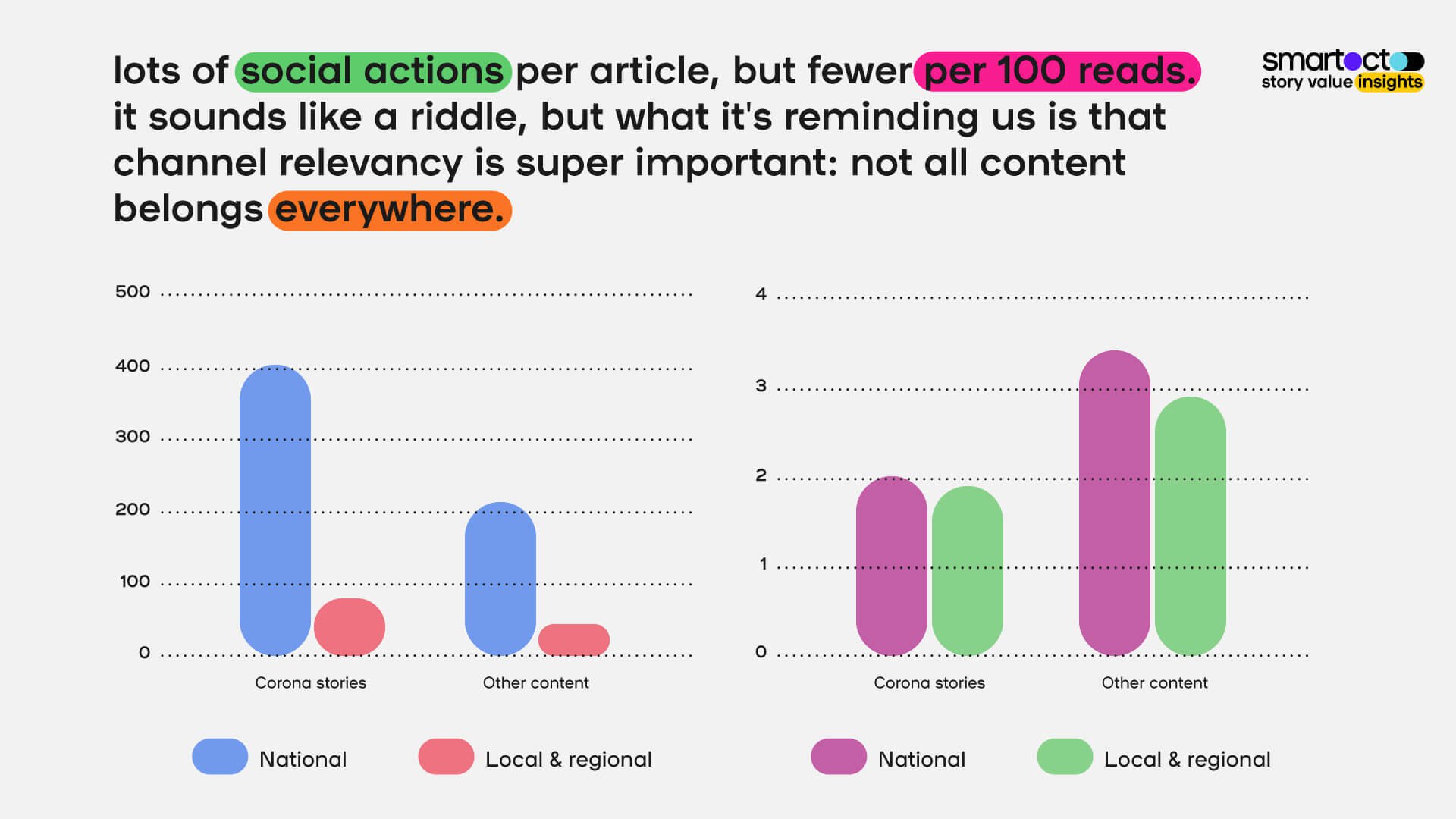
In fact, coronavirus content was not as ‘shareable’ as we might think if we look at the number of Social Actions per reads. The average number of Social Actions for non-corona stories in national publications during this period (per 100 readers) was 3.44 – for corona-related content, this was 2.02. So, for the non-mathsy folk in the room, that’s almost 40% more retweets, shares and likes for the regular stuff than the pandemic-centric content.
But, on a per-story level, the number of Social Actions per piece of corona-related content was almost twice as high per post. Large, national publications had on average 400 Social actions per virus-related story, while the number of Social Actions for other content was around 213. The same trend applied to smaller, local and regional publishers who recorded an average of 80 Social Actions per corona story, and 41 Social Actions on other content.
This is a question of platform relevancy. Social media is a place for conversation, and given that so much of the news about corona is so awful, it’s perhaps no surprise that content about it gets shared less over Facebook or Twitter. So, what’s the answer? Well, it’s to engage with those platforms as they were intended to be used: to converse. This is the place to publish about corona-adjacent subjects – things like dealing with loneliness, anxiety or boredom; sharing tips and stories about creative solutions to the issues the pandemic has presented us with.
Not all content belongs everywhere. Meet your readers where they’re at – they’re expecting a different experience on Instagram than they might on your homepage.
In the Netherlands we saw examples of large news platforms who made visual checklists of what their government had decided they could or couldn’t do during the ‘intellectual lockdown’ as they call it. That list was shared on social media and created a massive amount of engagement. What it showed was that people still need help with how to respond to government rules and guidelines. It’s eye-opening, and an inspirational example for mediabrands who want to start making content that has a practical use. Check out this post on corona-rules as an example.
5. Neighbours act like strangers
Even countries sharing borders or languages may act very differently when it comes to how they consume coronavirus content
It’s a given that different cultures have different attitudes towards the news. Reading habits vary between individuals, but our data also reveals larger national differences. During the coronavirus outbreak we discovered that even people in neighbouring countries showed huge differences in both levels of interest and levels of engagement on coronavirus stories.
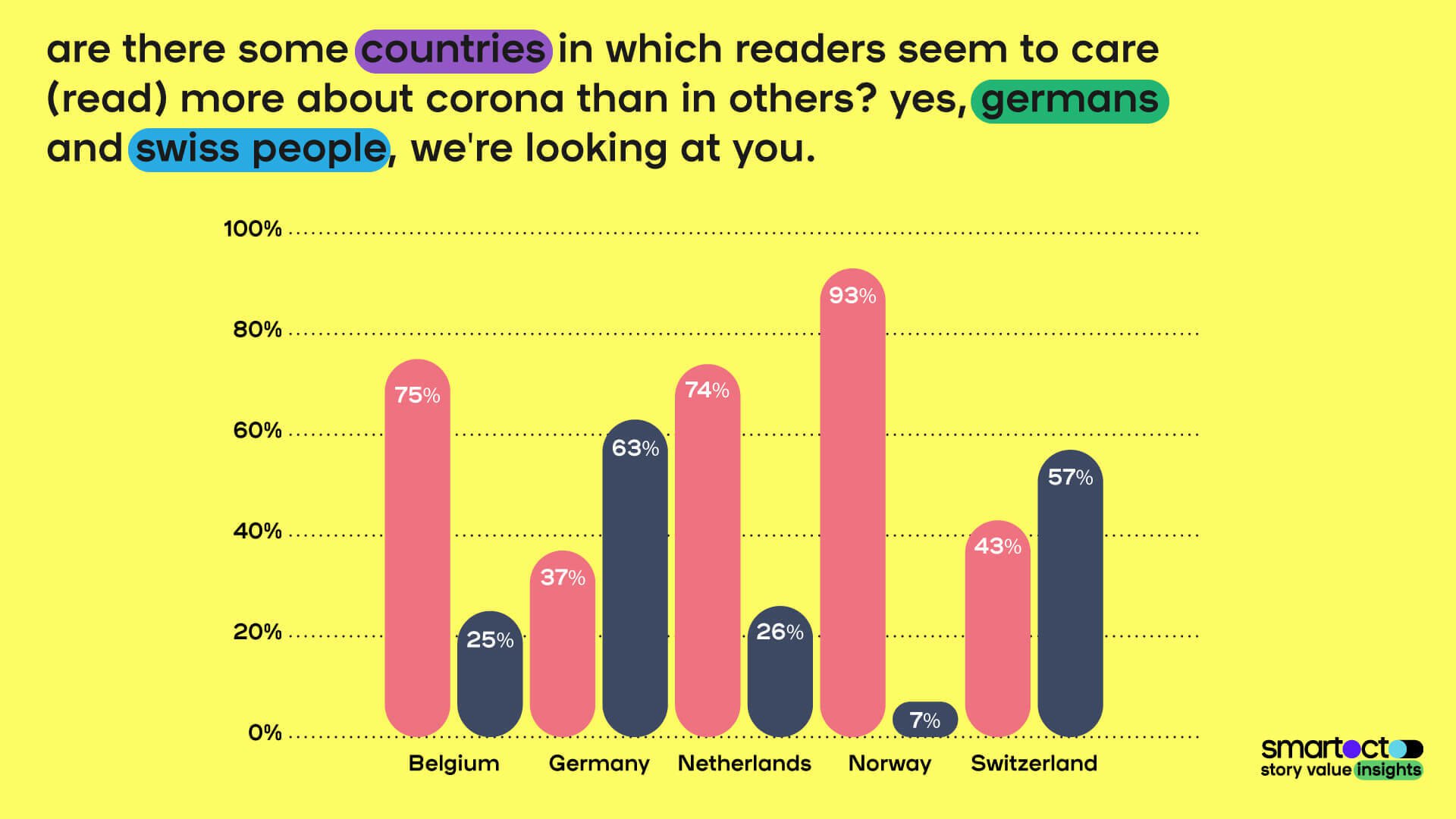
In Germany, during the first four months of 2020, 63% of all reads were on corona stories. It was a similar situation in Switzerland where 57% of reads were on virus-related content.
Over the border in Belgium and the Netherlands things looked different. In those two countries only 25% of reads were on the pandemic. The rate was even lower in Norway, at 7%.
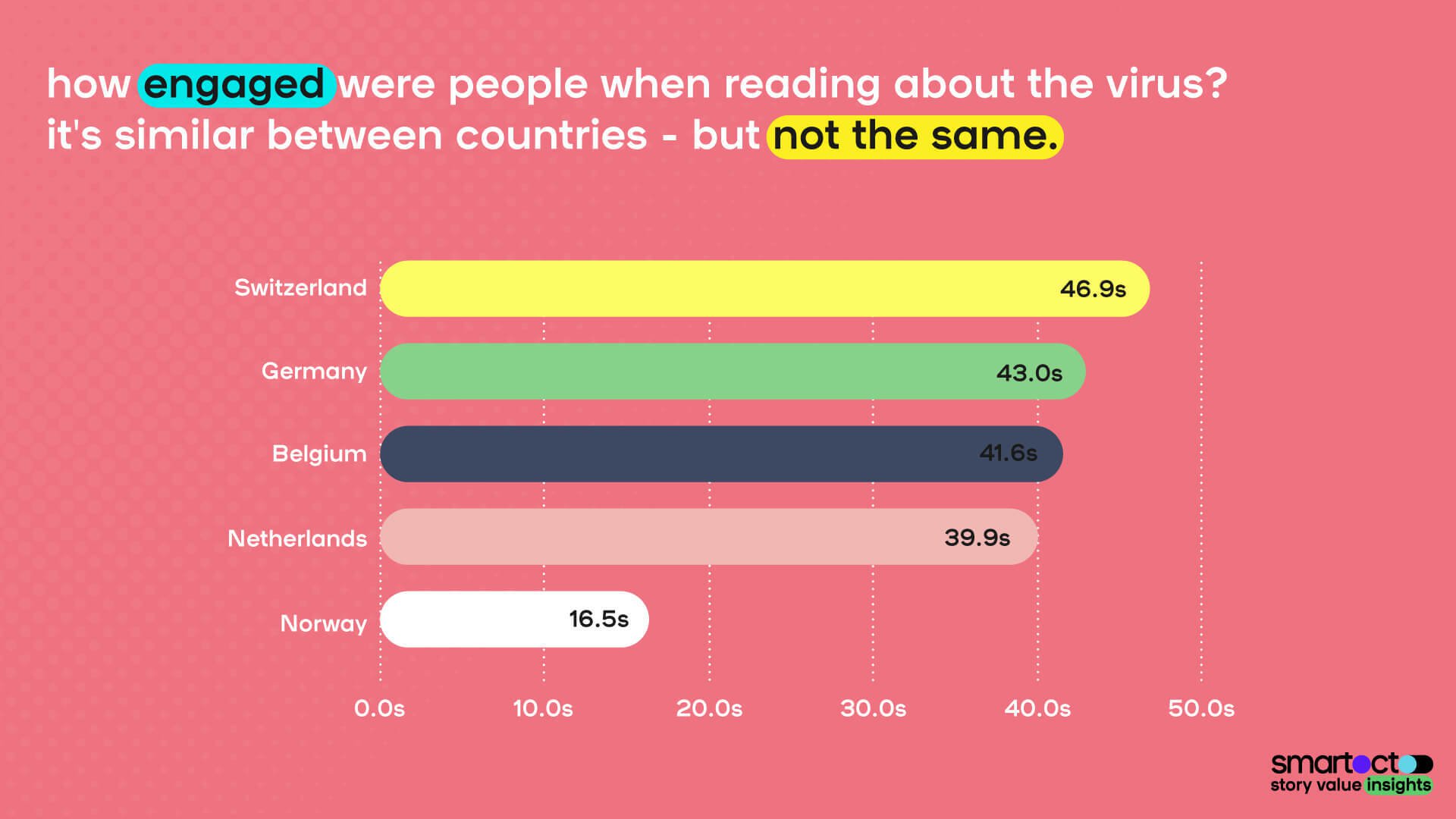
This pattern was reflected in Attention Time as well: Germany and Switzerland’s readers spent significantly longer on reading this kind of content compared to Norway.
So what was going on? There were more cases per capita in Belgium, so it wasn’t necessarily an issue of relevancy or a simple correlation between rates of infection and level of engagement. It’s possible that the kind of government regulations within a country might have had an effect on the way readers react to the news. But ultimately the lesson is this: we shouldn’t draw much more from the data other than the fact that cultural responses vary – and content will too.
Don’t assume what works for others will work for you. Generic rarely wins, and audience behaviour differs a surprising amount, even sometimes across short distances. Your strategy needs to have its roots in your own data: insights into how your brand intersects with your audience – and what their needs are.
So what have we learned?
A common thread through all these findings is actually something really simple. Newsrooms do best when they understand the intersection between their brand identity and their audience – and in the panic of everything that’s been happening, this focus is being lost.
Right now, readers are in turmoil – and that’s not hyperbole. In addition to the threat of the virus itself, there are the worries about the impact it might have on loved ones, whether their jobs are safe, what they’ll do about balancing work with childcare, and those are just for starters. There’s a lot going on.
It might not seem like the time to be doubling down on data, but – as these insights have started to show – it is. Doing what other newsrooms do is a crappy business model. Basing your strategy on the behaviour of your audience and your own brand identity is smart. Do that.
Milos Stanic & Em Kuntze
Republished with kind permission of smartocto, the world’s most actionable editorial analytics system offering a bird’s-eye view on The Story Life Cycle©.


